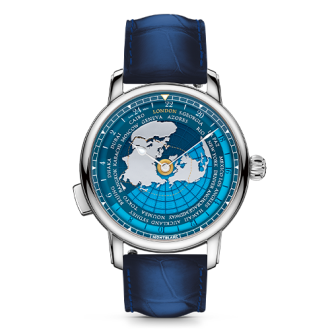The story behind the Montblanc Star Legacy Orbis Terrarum Around the World in 80 Days begins in 1872 with Jules Verne and his famous novel Around the World in 80 Days. This well-known tale, woven with intrigue and adventure, has held captive the imaginations of the young and the old for over 150 years.
For those unacquainted with the story, it all starts with a bet between two British gentlemen about whether it is possible to circumnavigate the globe in 80 days. The question is raised during a spirited card game of Whist that is being played between the main character Phileas Fogg, a precise and methodical English gentleman, and a companion from his distinguished society – the Reform Club in London. Fogg not only embraces the crazy idea, but also accepts the challenge, embarking on the journey that very evening from Charing Cross railway station, accompanied by his loyal French valet, Jean Passepartout.
This unusual evening marks the start of a truly remarkable journey that contains many unexpected adventures. Along the way, Fogg and Passepartout encounter various obstacles, detours, and even suspicions of criminal activity. The story captures the spirit of exploration of different cultures and a thrilling race against time.
A Race Against the Clock
Just like Fogg and Passepartout, the new 43mm, stainless steel, the Montblanc Star Legacy Orbis Terrarum Around the World in 80 Days was crafted to accompany adventurers on their journeys around the globe with its in-house worldtime complication that indicates 24 time zones at a glance.

Orbis Terrarum
The term “Orbis Terrarum” comes from the Latin for “circuit of the world” and was the name given to a world map created by the Roman general Marcus Vipsanius Agrippa in the first century AD. Agrippa needed a practical map that could be used for military purposes. Disregarding the elaborate maps previously made by the Greeks, he decided to create a round world map based on surveys of the extensive system of military roads running throughout the Roman empire. The map was sent to all the great cities in the empire, and even if no known copies are believed to have survived, this passion for maps and representations of our planet lives on in the Montblanc Star Legacy Orbis Terrarum Around the World in 80 Days.
A Journey Across the Dial
Phileas Fogg’s journey is depicted on a multi-layer dial that rotates with the movement mechanism. The dial depicts a world map as seen from the North Pole and uses a gold-colored transfer technique for some of the indications. The key cities on his route – San Francisco, New York, Queens Town, Yokohama, Hong Kong, Calcutta, Bombay, London, Aden, Suez, and Brindisi – are represented by gold dots, while the route itself is mapped out with 80 gold dashes. The names of different cities representing the 24 time zones are written on the dial around the map in white, while London, the city of departure, stands out in gold. The world map is completed with hands inspired by those found on 19th century pocket watches.
The Story Continues
The timepiece pays tribute to this journey around the world in every detail, from the dial to the caseback and even on the lining of the strap. The titanium caseback features a 3D laser engraving that brings both color, depth, and realism to a representation of the majestic and faithful elephant Kiouni who provided transport between Kholby and Allahabad in the novel.
Montblanc uses a special technique to highlight this incredible story, giving it an authentic 3D rendering, as if it was a photograph. Made of titanium, the metal must first be structured, which means that the decoration will be engraved by laser, taking into consideration the relief of the original drawing. Next, the desired finish (matte or shiny) is similarly achieved by laser. In the final phase, colors are created with laser-generated oxidation, with the level of oxidation determining the final result.
The caseback also features imagery of the impressive Allahabad Fort, the emblem of one of the most venerated cities in India, a Mongolian steamboat that provided the transport for Fogg and Passepartout’s adventurers between Italy and India, a traditional Japanese temple called Benten Yokohama that they passed along the way, and a locomotive from the Great Peninsular Railway that took them across the Indian lands. The adventures continue onto the lining of the strap with embossed Chinese coins and Boteh leaves discovered on the 80-day journey.
Calibre MB 29.20
The Montblanc Star Legacy Orbis Terrarum Around the World in 80 Days is powered by the MB 29.20 automatic calibre and comes with a Manufacture worldtime complication and approximately 42-hour power reserve.
How to Read the Time Zones
Once set, the user only has to press on the pusher located at eight o’clock until the reference city is at the top. The hour and minute hands will automatically synchronize to indicate the time in the city of choice. There is also a day/night indicator that works with a rotating disc that changes from light blue (for daylight hours) to dark blue (for the night), giving an overview of the passage of the sun around the planet.
This haute horlogerie timepiece is a testament to Montblanc’s expertise in crafting intuitive, practical complications in a contemporary fine watchmaking style, all the while celebrating the spirit of adventure that the Maison shares with Jules Verne and his renowned novel.






